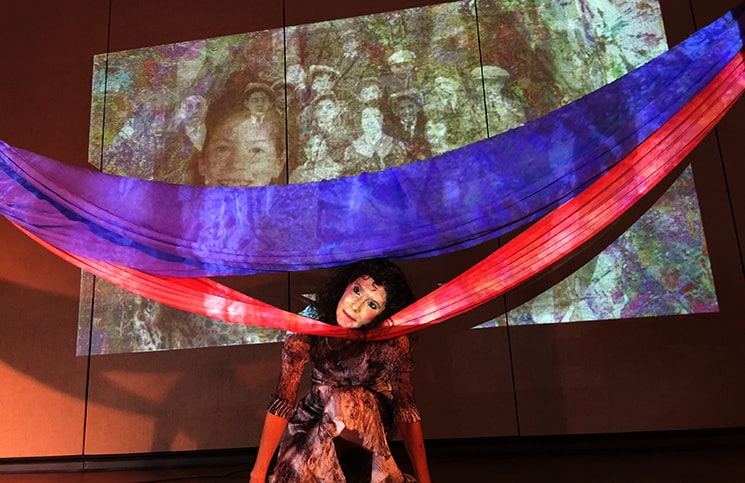The inspiration for “Life After Life” came to dancer Wendy Quinn in a dream. “There was a fragment of a set, with cloth billowing up above me. I woke up and thought, ‘I think I’m supposed to do this piece.’ I didn’t know what the piece was about,” she laughs. “I just had the set.”
“Life After Life” is a new contemporary dance and mixed-media performance by the married creative team of Wendy and Marty Quinn. According to Marty, the show is an exploration of the journeys, migrations, and cultural adaptations of Wendy’s family and her Jewish/Baha’i heritage. The show, on stage at 3S Artspace in Portsmouth on Friday and Saturday, Oct. 2 and 3, blends dance with music and visual art created by both Wendy and Marty.
Wendy Quinn is a visual artist and dancer with roots in the downtown performance art movement that thrived in New York City in the 1970s. Marty is a musician, composer, and computer scientist who uses software to translate data from nature into music.
“I think in doing this piece that I’m going back to my earlier work,” says Wendy. “For years, I’ve been studying ballet, and struggling to perfect. The danger with that, thinking that you to need fit into a mold, is losing one’s own voice and impulse to make art. It was a completely different approach with the avant garde work in the ’70s. It was about being yourself and letting things spring from within you and believing that that was valuable and had import. Also, not worrying about the audience or the critics — I was completely unaware of any of that. … So I’m trying in ‘Life After Life’ to regain that sense of my own true creativity.”
The Quinns frequently use their collaborations to approach a single idea through multiple disciplines. “The visuals are really important to me,” says Wendy. “I think that is my art school background coming through. We really believe strongly that every element should be connected to the overall goal of the piece, creating the environment that the piece is going to unfold in.”
“Science has knowledge and information about the world — but what you do with that knowledge is all about motivating the spirit. That’s where art can come into play.” — Marty Quinn
A recurring theme in “Life After Life” is the family tree, and it’s represented through sculpture, lighting, continuously shifting poly-visual projections of images of paleo-Hebrew writing, family documents, photos, and sacred Baha’i writings, as well as music that Marty composed using data collected from trees in Hubbard Brook Experimental Forest in the White Mountains.
“Tree data from the forest forms part of Wendy’s show,” says Marty. “There is one moment of breathing, the forest breathing at the same timespan as a human breathes. You can hear the evapotranspiration go by as marimba pitches. … It makes you think that there’s this melody underlying everything in nature. You can hear the emotion.”

Wendy Quinn performs Life After Life at 3S Artspace in Portsmouth this weekend. Photo by Marty Quinn.
Marty also harnesses data from within the human body (FMRI brain research) and without (solar ion and exo-planet readings) to create his audio landscapes. The integration of art and science is a strong feature in “Life After Life.”
“This summer, we were just invited to a National Science Foundation-sponsored workshop on the integration of arts, sciences and humanities,” he says. “At the conference, what emerged was that art can add an arc to science that leads to wisdom, action, and empathy. Science just does not have these characteristics on its own. Science has knowledge and information about the world — but what you do with that knowledge is all about motivating the spirit. That’s where art can come into play.”
The result of the couple’s work is a carefully crafted, multi-layered visual and auditory experience that supports a very personal narrative. “Here is a dancer in her world, and this is what’s in her psyche,” Wendy says. “The audience can see what she’s thinking about and what’s inside of her.”
Wendy says “Life After Life” was initially a collaboration with her daughter, who suggested Wendy focus on the family’s Jewish heritage. “For her, it’s an exciting, colorful aspect of her heritage, because she was raised Baha’i, but for me that history has a lot of pain. My approach to ‘Life After Life’ has been to uncover the signs that come to me. Why now? The dream? My daughter? I thought to myself, maybe this is what it is. This is the heart of my story, my Jewish family. This is the story that needs to be told.”
Wendy Quinn performs “Life After Life” Oct. 2-3 at 8 p.m. at 3S Artspace, 319 Vaughan St., Portsmouth. A panel discussion with the artists and local environmental scientists follows the performance. Tickets are $20, available at 3sarts.org.
